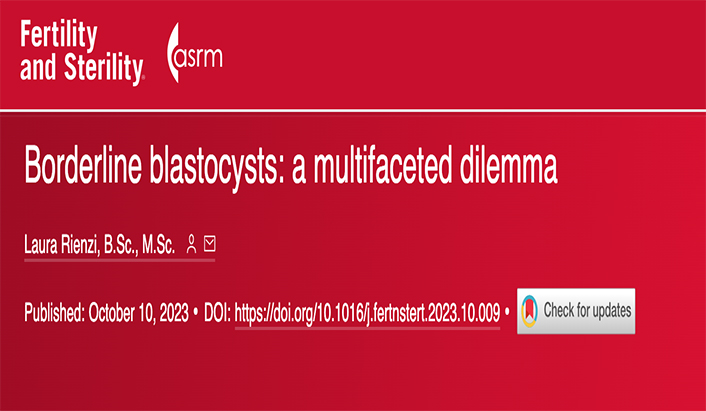
Laura Rienzi
Fertility and Sterility – 2023 Dec;120 (6):1150 – DOI:https://doi.org/10.1016/j.fertnstert.2023.10.009 Published:October 10 2023
Assisted reproductive technologies: old-fashioned approaches in a brand-new world
In the era of artificial intelligence and big data, an era when assisted reproduction is increasing in its application; corporate in vitro fertilization (IVF) has become a reality; and the higher standardization of clinical and laboratory protocols is evening out the performance across centers, embryologists and clinicians keep struggling every day in their clinics on every single case, often grounding their discussions on qualitative and highly subjective evaluations and/or old-fashioned practice.
The case of borderline blastocysts
The case of borderline blastocysts (i.e., day 7 and/or low-quality) is a clear example where the fate between being used clinically or being discarded is largely dependent on local regulations, biased evaluations, or pure opinions. An impasse exists because this is a multifaceted dilemma. The first issue resides in the definitions: where shall we set the threshold to call an embryo “day 7?” How can we reliably and consistently define a threshold of low embryo quality across clinics? The second issue is statistics: do we have enough reliable and unbiased data to investigate the true value of borderline blastocysts? The third issue is clinical with cost-effectiveness implications: is it reasonable to use embryos with a limited, yet not negligible, chance of resulting in healthy live births, or shall we rather opt for a further attempt aiming for faster-growing and/or higher-quality blastocysts? The last issue is ethics: when and how shall the patients be involved in the decision-making process regarding borderline blastocysts?
The origin of these doubts mostly resides in the wrong terminology, where “day 5 embryo” has been often used as a synonym for “blastocyst”; the fear of extending embryo culture beyond day 6; and the goal to maximize live birth rates per transfer by selecting the best-looking and fastest embryos.
A new patient-centered perspective in assisted reproductive technologies
Currently in assisted reproductive technologies, there is a (perhaps judicious) tendency to go back to the future and revise the concept of “success in IVF” by reframing it into a patient-centered and cumulative perspective (1 – 2). In vitro fertilization quality shall be measured as the cumulative live birth delivery rate per cycle or, even better, by minimizing the treatment discontinuation rates after an unsuccess on the basis of the cumulative live birth delivery rate per intention to treat within three cycles (3). Inside this frame, a blastocyst is any embryo that reaches this (highly resilient) stage of preimplantation development, regardless of its pace; extended embryo culture is an opportunity to benefit from the inherent self-selection of developmentally incompetent embryos; and artificial intelligence (with or without time-lapse microscopy) can help IVF professionals in objectifying future assessments by finally turning qualitative information into quantitative data.
Borderline quality blastocysts: a multifaceted dilemma to be faced by an heterogenous panel of experts
A multifaceted dilemma required a heterogenous panel of experts with conflicting opinions. Therefore, in this manuscript, we invited IVF professionals with both an academic and clinical background and expertise in molecular biology, clinical embryology, assisted reproductive technologies, and basic science, to battle on the opportunity of using borderline blastocysts—a conundrum with relevant clinical implications. In ancient Rome, people used to claim that in medio stat virtus, but, as I said, this is a brand-new world.
References
1.Maheshwari A. McLernon D. Bhattacharya S. Cumulative live birth rate: time for a consensus?. Hum Reprod. 2015; 30: 2703-2707
2. Rienzi L., Cimadomo D., Vaiarelli A., Gennarelli G., Holte J., Livi C., et al. Reprod Biomed Online.2021; 43: 775-778
3. Faustini F, Cimadomo D, Ubaldi FM, Rienzi L. From a cycle-by-cycle to a multicycle treatment planning: the next relevant shift in perspective needed in assisted reproductive technology? Fertil Steril. In press.
Trovate il testo completo a questo link https://www.fertstert.org/article/S0015-0282(23)01927-1/fulltext